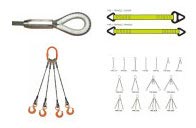Regardless of the type of sling used, mainly regarding material selection, it is essential to utilize slings properly. This article aims to help employees and employers correctly choose, maintain, and use slings to reduce hazards. In the material handling industry, the leading cause of the issue is human error. By having a deep understanding and always complying with OSHA standards for sling use, the highest levels of safety and operations can be maintained. It is essential to recognize that OSHA standards differ depending on the industry. The three most common industries that OSHA sling standards apply to are maritime, general industry, and construction.
Certain states have different OSHA-approved plans and requirements. According to the OSHA act, all programs are operated in conjunction with the United States Department of Labor. These programs differ from state to state, and as a result, it is vital to know the exact rules of where you operate.
OSHA has many different standards and recommendations for sling use and maintenance. These are legal requirements that you must know and comply with. The most important standard to focus on is directly related to the work being done. For instance, working in a general industry typically follows handling activities for CFR 1910.184. There are many related standards for overhead cranes and gantry cranes, which can be seen in 29 CFR 1926.251. By consulting the required standards for your industry and application, you can ensure full compliance with OSHA and state-approved plans.
What are the most common hazards you should look for?
OSHA guidelines highlight several common issues that all employers and employees should be mindful of. Repeated inspections help to identify many of these issues. If there’s ever a noticeable problem, big or small, it needs to be dealt with immediately.
Different sling materials have various applications and characteristics, which means you must use the right attachments or slings for specific loads and environments. Using nylon slings instead of metal or fiber variants could be potentially deadly for employees depending on the situation.
Related Reading about Wire Rope